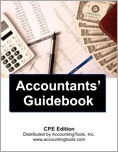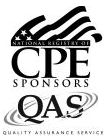Accountants' Guidebook (CPE Course)
CPE Credit: 30 hours
Course Type: Downloaded PDF materials with online test
Price (with PDF Textbook): $200
Course Description
The accountant is responsible for many activities, which may require years of training and experience to fully comprehend. The breadth of knowledge required can seem overwhelming. The Accountants’ Guidebook is designed to simplify matters by providing the accountant with a practical knowledge of how to complete many accounting tasks, while also imparting an understanding of the more critical accounting standards. Topics covered include accounting procedures, GAAP for common transactions, closing the books, producing financial statements and other reports, collection tactics, payroll management, budgeting, and much more. In short, this is the essential desk reference for the accountant.
Author: Steven Bragg
Course Number: AC1061
Table of Contents
Chapter 1. The Role of the Accountant
Chapter 2. The Chart of Accounts
Chapter 3. The General Ledger and Trial Balance
Chapter 4. Accounting Procedures
Chapter 5. Accounting for Receivables
Chapter 6. Accounting for Investments
Chapter 7. Accounting for Inventory
Chapter 8. Accounting for Property, Plant, and Equipment
Chapter 9. Accounting for Intangibles
Chapter 10. Accounting for Equity
Chapter 11. Revenue Recognition
Chapter 12. Accounting for Payroll
Chapter 13. Accounting for Stock-Based Compensation
Chapter 14. Accounting for Income Taxes
Chapter 15. Accounting for Business Combinations
Chapter 16. Foreign Currency Matters
Chapter 17. Accounting Changes and Error Corrections
Chapter 18. Closing the Books
Chapter 19. The Financial Statements
Chapter 20. Public Company Financial Reporting
Chapter 21. Management Reports
Chapter 22. Cash Receipts Management
Chapter 23. Collection Tactics
Chapter 24. Payroll Management
Chapter 25. Budgeting
Chapter 26. Capital Budgeting
Chapter 27. Business Ratios
Chapter 28. Cost Object Analysis
Learning Objectives
Identify the financial and managerial responsibilities of the accountant.
Cite the issues involved with different account code structures.
Specify how information rolls up from subsidiary ledgers into the general ledger, and is organized within the trial balance.
State the flow of various documents through the procedures used by the accountant. Also describe the structure of a procedure, and who is most concerned with its construction.
Identify the key requirements of accounting for receivables.
Cite the accounting for investment transfers and the impairment of securities.
Identify the tracking and cost accumulation systems used for inventory.
State the valuation and depreciation rules applicable to fixed assets.
Specify the rules regarding goodwill impairment and the capitalization of intangible assets.
Cite the rules related to the accounting for various equity transactions.
Identify the evaluation criteria for a contract, the components of the transaction price, and when a contract modification triggers treatment as a new contract.
Identify the proper accounting for the full range of payroll transactions.
Specify the accounting requirements related to stock-based compensation.
Itemize the treatment of tax differences, tax assets and liabilities, and the determination of tax rates.
Cite the accounting for a variety of transactions related to business combinations, as well as the uses of different types of acquisition structures.
Identify the accounting treatment for transactions involving foreign currency.
Cite the applicability of the accounting standards for accounting changes and error corrections to different scenarios.
Identify the steps required to close the books and generate financial statements.
Itemize the different formats in which the financial statements can be constructed, as well as the manner in which they are compiled.
Specify the theories under which interim period information is presented, as well as the rules for segment reporting, and the process of compiling public company reports.
State the types of variances and management report formats that an accountant may use.
Cite the process improvements that can be applied to the management of cash.
Identify the different types of collection tactics, as well as when they should be used.
Specify the best practices and confidentiality issues that should be implemented for a payroll system.
Identify the contents of the various budgets and which techniques should be used to populate the budgets.
State the methods used to examine proposed fixed asset purchases, and their outcomes after being installed.
Cite the calculation methods employed for those ratios most applicable to the role of the accountant.
Specify which costs are to be included in or excluded from the examination of cost objects, as well as how cost objects should be interpreted.
Level: Overview
Instructional Method: QAS Self-Study
NASBA Category: Accounting
Prerequisites: None
Advance Preparation: None
Latest Review Date: March 2024
Program Registration Requirements: Click on "Purchase Course" near the top of this page to pay for and access the course. You will then be able to download the course as a PDF file, then take an on-line examination, and then download a certificate of completion if you pass the examination.
Program Refund Policy: For more information regarding administrative policies concerning complaints, refunds, and other matters, see our policies page.
AccountingTools, Inc. is registered with the National Association of State Boards of Accountancy (NASBA) as a sponsor of continuing professional education on the National Registry of CPE Sponsors. State boards of accountancy have the final authority on the acceptance of individual courses for CPE credit. Complaints regarding registered sponsors may be submitted to the National Registry of CPE Sponsors through its website: www.nasbaregistry.org.
The NASBA sponsor identification number for Accountingtools, Inc. is 115881.
AccountingTools is an IRS Approved Continuing Education Provider. We are compliant with the requirements for continuing education providers (as described in sections 10.6 and 10.9 of the Department of Treasury’s Circular No. 230 and in other IRS guidance, forms, and instructions). Our IRS Approved Continuing Education Provider number is 72821.


